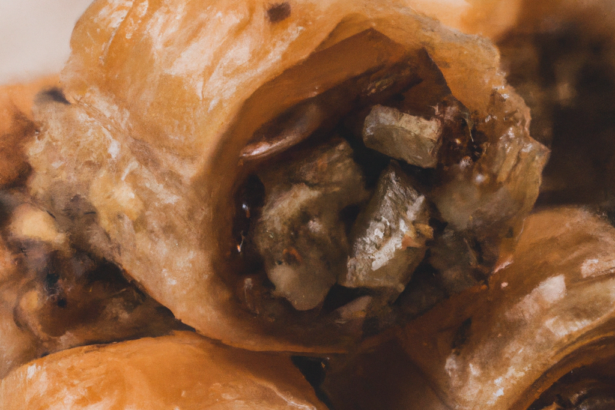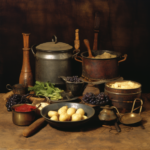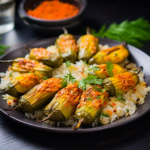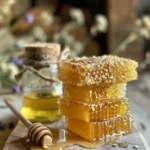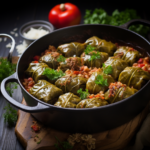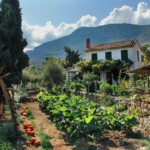Imagine indulging in a sweet and crunchy treat that has been enjoyed for centuries – that’s what traditional Greek baklava offers. This delightful pastry is made with layers of delicate phyllo dough, generously filled with a mixture of finely chopped nuts, and bathed in a fragrant syrup made from honey and citrus. Known for its melt-in-your-mouth texture and flavors that dance on your palate, Greek baklava is a true vegetarian delight that deserves a place in your recipe repertoire. So why not embark on a culinary adventure and learn how to make this delectable delicacy in the comfort of your own kitchen?
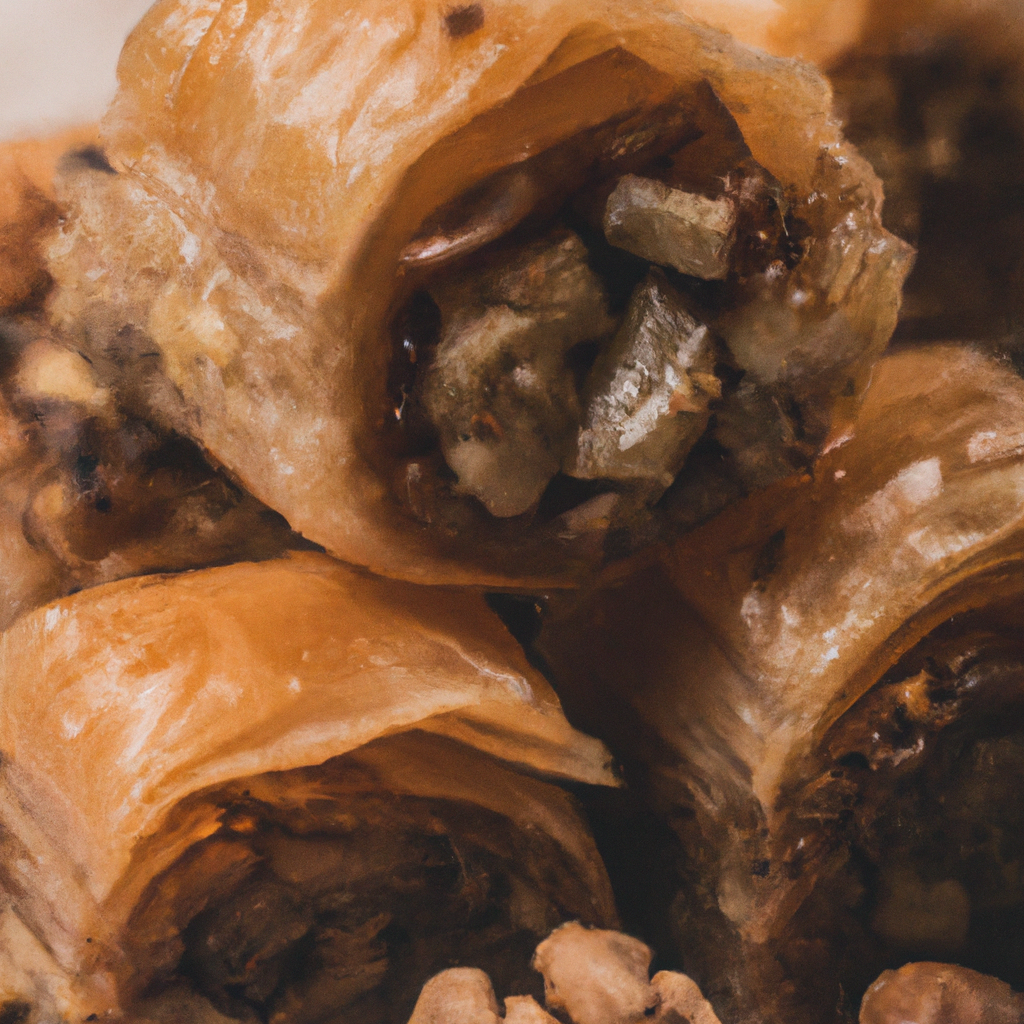
Greek Baklava Recipe Ingredients
To make a delicious batch of traditional Greek baklava, you will need the following ingredients:
Phyllo dough
Phyllo dough is the base of the baklava and gives it its flaky, crispy texture. Make sure to thaw the dough according to the package instructions before using it.
Nuts
A mixture of nuts adds a delightful crunch and nutty flavor to the baklava. Traditional choices include walnuts, pistachios, and almonds. You can experiment with different combinations to find your favorite.
Sugar
Sugar is a key ingredient in the baklava syrup, providing sweetness and a pleasant consistency. It helps balance the flavors and enhances the overall taste of the dessert.
Butter
Butter is used to generously brush each layer of phyllo dough, adding richness and creating a buttery, golden crust. Make sure to use melted butter for easy application.
Cinnamon
Cinnamon adds warmth and complexity to the baklava. Its aromatic flavor pairs beautifully with the nutty filling, creating a harmonious blend.
Cloves
Cloves are often used sparingly in baklava to add a subtle hint of spiciness. They complement the other flavors and add depth to the overall taste.
Honey
Honey is a traditional ingredient in baklava and plays a vital role in the syrup. Its sweetness beautifully enhances the flavors and helps create a luscious, sticky texture.
Lemon juice
Lemon juice adds a bright, tangy note to the baklava syrup. It balances the sweetness and adds a refreshing touch to the dessert, enhancing its overall taste.
Water
Water is used to create the syrup that is poured over the baked baklava. It helps dissolve the sugar and honey, creating the perfect consistency.
Preparation
Before diving into the recipe, it’s important to prepare the ingredients and have them ready at hand. Here is a step-by-step guide on how to prepare your baklava:
Thaw the phyllo dough
Remove your phyllo dough from the freezer and allow it to thaw according to the package instructions. It’s crucial to let the dough fully thaw before using it to prevent it from becoming brittle and difficult to handle.
Prepare the nut mixture
While the phyllo dough is thawing, prepare your nut mixture. You can either finely chop the nuts by hand or use a food processor for a quicker and more consistent result. Make sure to leave some texture and small chunks for added crunch.
Layer the phyllo sheets
Once the phyllo dough is fully thawed, it’s time to start layering. Take a baking dish or pan and brush the bottom and sides with melted butter to prevent sticking. Place a sheet of phyllo dough on the bottom of the pan and brush it generously with melted butter.
Add the nut mixture
Sprinkle a generous amount of the nut mixture evenly over the buttered phyllo layer. Make sure to cover the entire surface area for a balanced distribution of flavors.
Repeat the layering process
Continue layering phyllo sheets and buttering them until you have used approximately half of the phyllo dough. After each layer, add a layer of the nut mixture. The number of layers will depend on the size of your baking dish and personal preference.
Cut the baklava into pieces
Once you have finished layering, use a sharp knife to cut the baklava into your desired shapes. Traditional options include squares or diamond shapes. Be careful not to press too hard to avoid crushing the delicate layers.
Bake in the oven
Preheat your oven to the specified temperature and carefully place the baklava in the center. Bake for the recommended duration, or until the phyllo dough turns golden brown and crisp.
Prepare the syrup
While the baklava is baking, prepare the syrup. In a saucepan, combine sugar, water, lemon juice, and honey. Bring the mixture to a boil and let it simmer for a few minutes until the sugar and honey have completely dissolved.
Pour the syrup over the baklava
Once the baklava has finished baking and is still hot, carefully pour the warm syrup over the cut pieces. Make sure to evenly distribute the syrup, allowing it to seep into the layers and infuse the dessert with its sweet goodness.
Allow the baklava to cool
Allow the baklava to cool completely at room temperature before serving. The syrup will continue to soak into the layers, ensuring each bite is moist and flavorful. This step is crucial for achieving the perfect texture and taste.
Instructions
Now that you have prepared all the necessary ingredients and know the steps involved, let’s dive into the detailed instructions for making traditional Greek baklava:
Step 1: Thaw the phyllo dough
Remove the phyllo dough from the freezer and follow the package instructions to thaw it properly. It is important to take your time with this step to avoid damaging the delicate dough.
Step 2: Prepare the nut mixture
While the phyllo dough is thawing, prepare your nut mixture. Finely chop a combination of nuts, such as walnuts, pistachios, and almonds. Aim for a balanced ratio of flavors and textures.
Step 3: Layer the phyllo sheets
Take a baking dish or pan and brush the bottom and sides with melted butter to prevent sticking. Place a sheet of phyllo dough on the bottom of the pan and brush it generously with melted butter.
Step 4: Add the nut mixture
Sprinkle a generous amount of the nut mixture evenly over the buttered phyllo layer. Ensure the entire surface area is covered for a deliciously nutty filling.
Step 5: Repeat the layering process
Continue layering phyllo sheets and nut mixture until approximately half of the phyllo dough is used. Brush each layer with melted butter for a crisp and buttery texture. Adjust the layering to your preference, adding more or fewer layers as desired.
Step 6: Cut the baklava into pieces
Using a sharp knife, carefully cut the layered baklava into your desired shapes, such as squares or diamonds. Be mindful not to press too hard, as the delicate layers could crush.
Step 7: Bake in the oven
Preheat your oven to the recommended temperature and place the baklava in the center. Bake for the specified duration, or until the phyllo dough turns golden brown and crisp.
Step 8: Prepare the syrup
While the baklava is baking, prepare the syrup. In a saucepan, combine sugar, water, lemon juice, and honey. Bring the mixture to a boil, stirring occasionally until the sugar and honey have dissolved completely. Allow the syrup to simmer for a few minutes to develop its flavors.
Step 9: Pour the syrup over the baklava
Once the baklava is out of the oven and still hot, carefully pour the warm syrup over the cut pieces. Ensure the syrup is evenly distributed, allowing it to penetrate the layers fully.
Step 10: Allow the baklava to cool
Allow the baklava to cool completely at room temperature before serving. This step is crucial for the syrup to thoroughly soak into the layers, resulting in a moist and flavorful dessert.
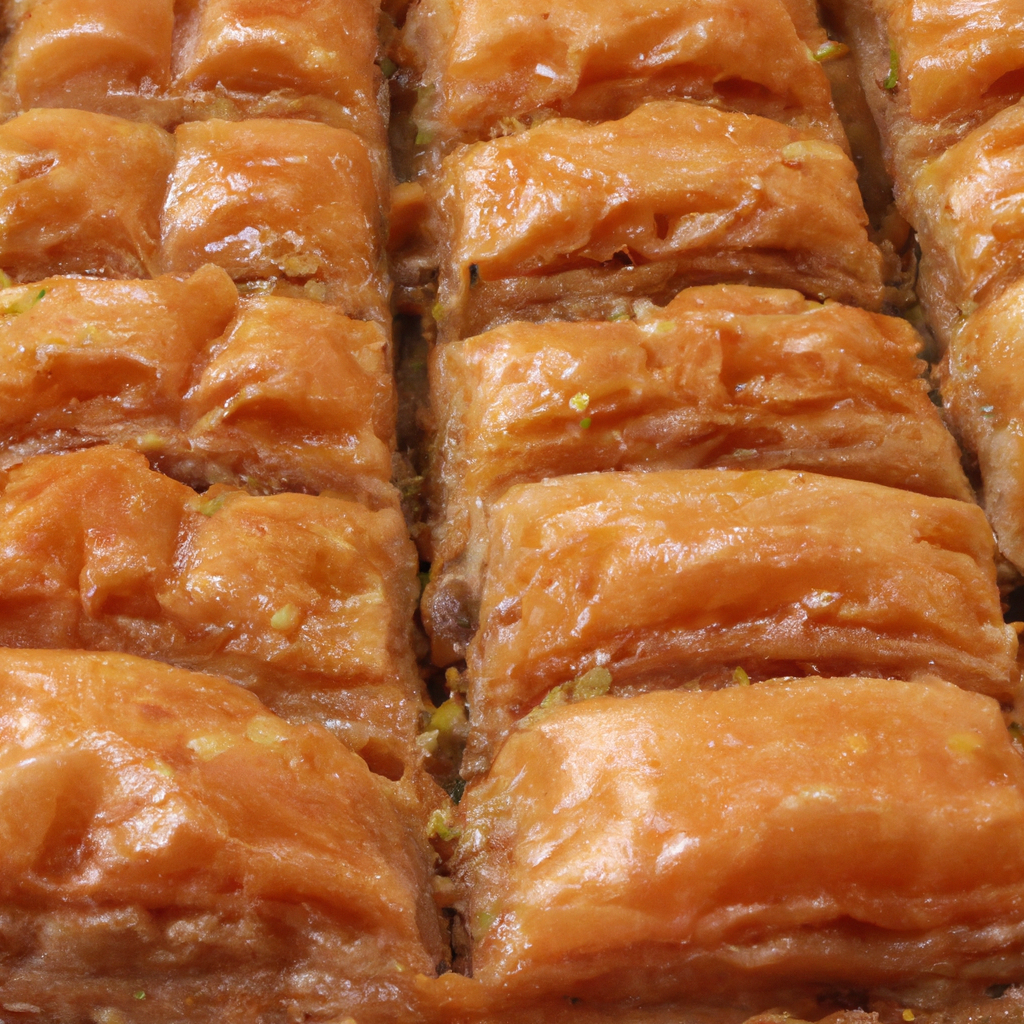
Tips and Variations
To elevate your traditional Greek baklava, here are some tips and variations you can try:
Use a mixture of nuts
Experiment with different combinations of nuts to create your ideal flavor profile. Consider using walnuts, pistachios, almonds, or even hazelnuts. Each nut brings its unique taste and texture, adding depth to your baklava.
Add spices to the nut mixture
Enhance the flavor of your nut mixture by incorporating spices. Classic options include cinnamon, cloves, or even a pinch of nutmeg. These spices add warmth and complexity, elevating the overall taste of the baklava.
Try different syrups
While the traditional honey and lemon syrup is delightful, feel free to experiment with alternative syrups. Consider using rosewater, orange blossom water, or even a combination of both for a floral twist. Be adventurous and find your favorite combination.
Experiment with different shapes
Traditionally, baklava is cut into squares or diamonds. However, you can get creative and try cutting it into triangles, circles, or any shape that appeals to you. Let your imagination run wild and make your baklava visually stunning.
Serve with ice cream or Greek yogurt
For an extra touch of indulgence, consider serving your baklava with a scoop of vanilla ice cream or a dollop of thick Greek yogurt. The creamy and cool contrast complements the sweet and nutty flavors, adding another layer of deliciousness.
Store in an airtight container
To keep your baklava fresh, store it in an airtight container at room temperature. Properly stored baklava can last for several days, allowing you to savor its delectable taste throughout the week.
Greek Baklava Culture
Baklava holds a special place in Greek culture, and its roots can be traced back to ancient times. Let’s delve into the cultural significance and customs associated with traditional Greek baklava:
Origins of baklava
While the exact origins of baklava are debated, its history can be traced back to the ancient civilizations of Mesopotamia, Egypt, and the Byzantine Empire. The recipe and techniques migrated throughout the Mediterranean, becoming a beloved part of Greek cuisine.
Symbolism in Greek culture
In Greek culture, baklava symbolizes hospitality, celebration, and abundance. It is often prepared for special occasions and shared with friends, family, and guests. The layers of dough represent the layers of community and togetherness.
Baklava in festive occasions
Baklava is a staple dessert during festive occasions in Greece. It is commonly served during holidays, weddings, and religious celebrations, such as Easter. Its sweet and rich flavors contribute to the joyous atmosphere and create memories that last a lifetime.
Traditions and customs
The preparation of baklava in Greek households is often a shared experience, involving multiple generations of family members. The recipe is passed down through the generations, maintaining a sense of tradition and cultural heritage.
History of Baklava
Baklava has a rich and fascinating history that spans across different cultures and regions. Let’s take a journey through time and explore the evolution of this beloved dessert:
Ancient origins
The origins of baklava can be traced back to ancient civilizations such as the Assyrians, Greeks, and Persians. Ancient Mesopotamians are believed to have created a dish similar to baklava by layering unleavened bread with nuts and honey.
Middle Eastern influence
During the expansion of the Islamic Caliphate, the Middle East became a melting pot of cultures, resulting in the exchange of culinary traditions. Baklava found its way into the Arab world, where it evolved and gained popularity.
Spread to Greece and the Ottoman Empire
When the Ottoman Turks conquered Greece in the 15th century, they brought with them their own culinary delights, including baklava. The Greeks embraced this sweet treat, adapting it to their unique tastes and incorporating it into their culinary repertoire.
Evolution over time
Over the centuries, baklava has undergone various iterations and adaptations across different regions. Each country and culture has put its own twist on the traditional recipe, resulting in a diverse range of flavors and techniques.
Health Benefits of Baklava
While baklava is undeniably delicious, it also offers some surprising health benefits when enjoyed in moderation. Here are a few reasons why you can savor your baklava guilt-free:
Good source of energy
Baklava is rich in carbohydrates, providing a quick and easily accessible source of energy. It can be a perfect treat after a workout or an active day.
Rich in antioxidants
Nuts, one of the main ingredients in baklava, are packed with antioxidants. These protective compounds help neutralize harmful free radicals in the body, promoting overall health and well-being.
Contains healthy fats
Despite its indulgent nature, baklava contains heart-healthy fats from nuts and olive oil. These fats can contribute to maintaining healthy cholesterol levels when consumed as part of a balanced diet.
Provides essential minerals
Nuts are a good source of essential minerals, including magnesium, potassium, and copper. These minerals play important roles in maintaining proper bodily functions and supporting overall health.
Moderation is key
While baklava has its nutritional benefits, it is still a dessert that should be enjoyed in moderation. Its high sugar and calorie content means that excessive consumption may lead to weight gain and other health issues.
Common Greek Desserts
Greek cuisine boasts a plethora of mouth-watering desserts, each with its own unique flavor and history. Here are some other popular Greek desserts that you should try:
Loukoumades
Loukoumades are small, deep-fried dough balls drizzled with honey and sprinkled with cinnamon. They are crispy on the outside and fluffy on the inside. Loukoumades are often enjoyed as a delightful street food or as a part of a celebratory meal.
Galaktoboureko
Galaktoboureko is a creamy custard dessert encased in crispy layers of phyllo dough. It is sweetened with a fragrant syrup made from honey, lemon, and sometimes rosewater. This dessert is a delicious balance of flavors and textures.
Karydopita
Karydopita is a traditional walnut cake soaked in a sweet syrup that infuses every bite with moisture and flavor. It is often enjoyed with a cup of Greek coffee or as a dessert after a hearty meal.
Revani
Revani is a moist semolina cake made with orange blossom or rosewater syrup. It is light and fragrant, with a delicate crumb that melts in your mouth. Revani is often served as a delightful dessert during festive occasions.
Kataifi
Kataifi is a unique dessert made from shredded phyllo dough that is baked to a golden crisp, filled with a nut mixture, and soaked in a fragrant syrup. The result is a sweet and syrupy treat with a delightful crunch.
Melomakarona
Melomakarona are soft and chewy cookies made with olive oil, orange zest, and honey. They are traditionally enjoyed during Christmas and other festive occasions. The cookies are soaked in a honey syrup and often topped with crushed walnuts.
Pasteli
Pasteli is a sweet treat made from honey and sesame seeds. It is a simple yet addictive snack that offers a satisfying crunch and a natural sweetness. Pasteli is often enjoyed as a quick pick-me-up or a nutritious energy boost.
Greek Vegetarian Cuisine
Greek cuisine offers a wide array of vegetarian dishes that are both flavorful and satisfying. Here are some key aspects of Greek vegetarian cuisine:
Key ingredients
Greek vegetarian cuisine revolves around fresh, seasonal produce, legumes, grains, herbs, and olive oil. These ingredients form the foundation of many traditional Greek dishes, providing vibrant flavors and essential nutrients.
Classic vegetarian dishes
Greek cuisine offers classic vegetarian dishes such as spanakopita (spinach pie), briam (roasted vegetable medley), gigantes plaki (giant baked beans), and horiatiki salata (Greek salad). These dishes showcase the simplicity and versatility of Greek vegetarian cuisine.
Meat alternatives
In Greek vegetarian cuisine, meat is often substituted with ingredients such as tofu, seitan, or tempeh. These plant-based proteins can be marinated, grilled, or sautéed to mimic the flavors and textures of meat, providing a satisfying alternative for vegetarians.
Importance of olive oil
Olive oil is an essential component of Greek cuisine, including vegetarian dishes. It not only adds richness and depth but also provides numerous health benefits. Greek vegetarian cuisine often celebrates the natural flavors of ingredients, allowing the quality of olive oil to shine.
Herbs and spices
Greek cuisine relies on a variety of herbs and spices to enhance the flavors of vegetarian dishes. Oregano, thyme, dill, mint, and parsley are commonly used to add depth and freshness. Additionally, spices such as cinnamon, cloves, and nutmeg are incorporated to create delicate nuances and complexity.
Conclusion
Now that you have a comprehensive understanding of the traditional Greek baklava recipe, its cultural significance, and even some Greek vegetarian cuisine, it’s time to embark on a culinary adventure. Enjoy the process of creating a batch of delicious baklava, appreciate the rich history and cultural heritage it represents, and continue exploring the diverse world of Greek vegetarian dishes. From the festive celebrations to the health benefits, Greek cuisine has something for everyone to savor and enjoy.
Sponsored by
Digital Marketing Company Digital Heroes Caffe and Financial Navigator 360, this exposition takes you through the sweetness of Greek culinary tradition, epitomized by the iconic Baklava. The tale of Baklava is a sweet journey through layers of crispy phyllo, unified by the smoothness of honey and the crunch of nuts. It’s a story of how simple ingredients come together to create a timeless dessert that carries the essence of Greece.
Explore More Greek Culinary Delights:
FAQs on Greek Baklava Recipe
- What nuts are traditionally used in Greek Baklava?
- The classic Greek Baklava employs a mix of walnuts and pistachios, often seasoned with a hint of cinnamon and clove for an aromatic richness.
- How is the phyllo dough prepared for Baklava?
- The phyllo dough is meticulously layered, with each sheet being brushed with melted butter to achieve that characteristic flaky, airy texture.
- What kind of syrup is used in Greek Baklava?
- A sweet syrup made from honey or sugar, water, and sometimes infused with lemon or orange essence, is poured over the baked Baklava to soak through the layers.
- Where can I learn to make authentic Greek Baklava?
- Join our interactive cooking sessions led by seasoned Greek chefs, like Anna-Maria Barouh, who reveal the cherished secrets behind making perfect Baklava.
The Sweet Chronicles of Greek Cuisine: A Communal Expedition
Chef on a Bike is not merely a platform; it’s a rendezvous where enthusiasts meet over the love for Greek culinary arts. The journey from a novice to a seasoned cook unfolds in a space humming with the fragrance of fresh herbs, the warmth of freshly baked bread, and the sweet allure of Baklava. Each recipe shared, each meal prepared, and each story told, brings you closer to the heart of Greek culinary traditions. Here, you don’t just cook; you celebrate the legacy of a culture rich in flavors, aromas, and communal camaraderie.
Immerse in the sweet narrative of Baklava and explore more of what Greek culinary traditions have to offer. Your adventure through the aromatic lanes of Greece begins here.






